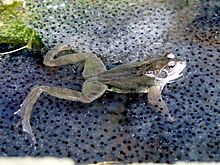Brown frogs


The term brown frogs summarizes various holarctic species of frogs from the genus of real frogs ( Rana ), which are related in morphological and ecological features and differentiate them from other frogs (especially: water frogs ). The appearance is characterized by a mostly brownish basic color on the upper side, the presence of a triangular, dark "temple spot" behind each eye and a relatively wide interpupillary distance. The mating calls of the males are comparatively quiet, as they have no or only internal sound bubbles .
Ecologically, brown frogs are characterized by their predominantly terrestrial way of life over the course of the year (exception: some southern European species that live permanently on mountain streams) and their quality as "explosive spawners". The adult animals of a population gather directly after the hibernation collectively at a - usually ancestral - spawning water , in order to then leave larger amounts of spawning in the form of balls in the shallow water within a few days . Then they quickly return to their land habitats (often forests, moors, wooded meadows / pastures).
In Central Europe, the following species are included in this group:
- Common Frog ( Rana temporaria )
- Moor frog ( Rana arvalis )
- Agile frog ( Rana dalmatina )
The following species occur in southern Europe:
- Italian agile frog ( Rana latastei )
- Greek frog ( Rana graeca )
- Italian frog ( Rana italica )
- Spanish frog ( Rana iberica )
- Pyrenean frog ( Rana pyrenaica )
In Asia Minor and the Caucasus, this includes:
- Asian brown frog ( Rana macrocnemis )
In North America, the wood frog ( Rana sylvatica / Lithobates sylvaticus ) can be called a "brown frog".